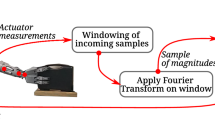Abstract
We present active object categorization experiments with a real humanoid robot. For this purpose, the training algorithm of a recurrent neural network with parametric bias has been extended with adaptive learning rates. This modification leads to an increase in training speed. Using this new training algorithm we conducted three experiments aiming at object categorization. While holding different objects in its hand, the robot executes a motor sequence that induces multi-modal sensory changes. During learning, these high-dimensional perceptions are ‘engraved’ in the network. Simultaneously, low-dimensional PB values emerge unsupervised. The geometrical relation of these PB vectors can then be exploited to infer relations between the original high dimensional time series characterizing different objects. Even sensations belonging to unknown objects can be discriminated from known (learned) ones and kept apart from each other reliably. Additionally, we show that the network tolerates noisy sensory signals very well.
Access this chapter
Tax calculation will be finalised at checkout
Purchases are for personal use only
Preview
Unable to display preview. Download preview PDF.
Similar content being viewed by others
References
O’Regan, J.K., Noë, A.: A sensorimotor account of vision and visual consciousness. Behav. Brain Sci. 24(5) (October 2001); 939–73; discussion 973–1031
Dill, M., Wolf, R., Heisenberg, M.: Visual pattern recognition in drosophila involves retinotopic matching. Nature 365(6448), 751–753 (1993)
Franceschini, N.: Combined optical, neuroanatomical, electrophysiological and behavioral studies on signal processing in the fly compound eye. In: Taddei-Ferretti, C. (ed.) Biocybernetics of Vision: Integrative Mechanisms and Cognitive Processes: Proceedings of the International School of Biocybernetics, Casamicciola, Napoli, Italy, October 16-22, 1994, vol. 2, World Scientific, Singapore (1997)
Steinman, S.B., Steinman, B.A., Garzia, R.P.: Foundations of binocular vision: a clinical perspective. McGraw-Hill, New York (2000)
Pfeifer, R., Lungarella, M., Iida, F.: Self-organization, embodiment, and biologically inspired robotics. Science 318(5853), 1088–1093 (2007)
Tani, J., Ito, M.: Self-organization of behavioral primitives as multiple attractor dynamics: A robot experiment. IEEE Transactions on Systems, Man and Cybernetics, Part A: Systems and Humans 33(4), 481–488 (2003)
Tani, J., Ito, M., Sugita, Y.: Self-organization of distributedly represented multiple behavior schemata in a mirror system: reviews of robot experiments using RNNPB. Neural Netw. 17(8-9), 1273–1289 (2004)
Cuijpers, R.H., Stuijt, F., Sprinkhuizen-Kuyper, I.G.: Generalisation of action sequences in RNNPB networks with mirror properties. In: Proceedings of the 17th European symposium on Artifical Neural Networks (ESANN), pp. 251–256 (2009)
Kolen, J.F., Kremer, S.C.: A field guide to dynamical recurrent networks. IEEE Press, New York (2001)
Riedmiller, M., Braun, H.: A direct adaptive method for faster backpropagation learning: the RPROP algorithm. In: IEEE International Conference on Neural Networks, vol. 1, pp. 586–591 (1993)
LeCun, Y.A., Bottou, L., Orr, G.B., Müller, K.-R.: Efficient BackProp. In: Orr, G.B., Müller, K.-R. (eds.) NIPS-WS 1996. LNCS, vol. 1524, pp. 9–50. Springer, Heidelberg (1998)
Bradski, G.: The OpenCV Library. Dr. Dobb’s Journal of Software Tools (2000)
Suzuki, S., Be, K.: Topological structural analysis of digitized binary images by border following. Computer Vision, Graphics, and Image Processing 30(1), 32–46 (1985)
Hu, M.K.: Visual pattern recognition by moment invariants. IRE Transactions on Information Theory 8(2), 179–187 (1962)
Chang, C.C., Lin, C.J.: LIBSVM: A library for support vector machines. ACM Transactions on Intelligent Systems and Technology 2, 27:1–27:27 (2011)
Kleesiek, J., Badde, S., Wermter, S., Engel, A.K.: What do Objects Feel Like? Active Perception for a Humanoid Robot. In: Proceedings of the 4th International Conference on Agents and Artificial Intelligence (ICAART), vol. 1, pp. 64–73 (2012)
Meltzoff, A.N., Meltzoff, A.N., Moore, M.K.: Explaining facial imitation: a theoretical model. Early Development and Parenting 6, 179–192 (1997)
Gibson, J.J.: The theory of affordances. In: Shaw, R., Bransford, J. (eds.) Perceiving, Acting, and Knowing: Toward an Ecological Psychology, pp. 67–82. Erlbaum, Hillsdale (1977)
Ogata, T., Ohba, H., Tani, J., Komatani, K., Okuno, H.G.: Extracting multi-modal dynamics of objects using RNNPB. In: Proc. IEEE/RSJ Int. Conf. on Intelligent Robots and Systems, Edmonton, pp. 160–165 (2005)
Körding, K.P., Wolpert, D.M.: Bayesian integration in sensorimotor learning. Nature 427(6971), 244–247 (2004)
Author information
Authors and Affiliations
Editor information
Editors and Affiliations
Rights and permissions
Copyright information
© 2013 Springer-Verlag Berlin Heidelberg
About this paper
Cite this paper
Kleesiek, J., Badde, S., Wermter, S., Engel, A.K. (2013). Action-Driven Perception for a Humanoid. In: Filipe, J., Fred, A. (eds) Agents and Artificial Intelligence. ICAART 2012. Communications in Computer and Information Science, vol 358. Springer, Berlin, Heidelberg. https://doi.org/10.1007/978-3-642-36907-0_6
Download citation
DOI: https://doi.org/10.1007/978-3-642-36907-0_6
Publisher Name: Springer, Berlin, Heidelberg
Print ISBN: 978-3-642-36906-3
Online ISBN: 978-3-642-36907-0
eBook Packages: Computer ScienceComputer Science (R0)




